Romanian leu
| Romanian leu | |||||
|---|---|---|---|---|---|
| Leu românesc (Romanian) | |||||
| |||||
| ISO 4217 | |||||
| Code | RON | ||||
| Denominations | |||||
| Subunit | |||||
| 1/100 | ban | ||||
| Plural | lei | ||||
| ban | bani | ||||
| Banknotes | |||||
| Freq. used | 1 leu, 5, 10, 50, 100, 200 lei | ||||
| Rarely used | 500 lei | ||||
| Coins | |||||
| Freq. used | 5, 10, 50 bani | ||||
| Rarely used | 1 ban, | ||||
| Demographics | |||||
| User(s) |
former: | ||||
| Issuance | |||||
| Central bank |
National Bank of Romania (since 1867) Red Army (1944) INFINEX (1941-1944) General Romanian Bank (1917-1919) | ||||
| Website |
www | ||||
| Printer |
National Bank of Romania (since 1867) Goznak (1944) Reichsbank (1917-1919) | ||||
| Website |
www | ||||
| Mint |
Monetăria Statului (since 1867) Saint Petersburg Mint, temporary located in Krasnokamsk (1944) Reichsdruckerei (1917-1919) | ||||
| Website |
www | ||||
| Valuation | |||||
| Inflation | -0.43% (October 2016 / October 2015)[1] | ||||
| Source | National Bank of Romania[2] | ||||
The Romanian leu, Romanian Lion (Romanian pronunciation: [lew], plural lei [lej]; ISO 4217 code RON; numeric code 946) is the currency of Romania. It is subdivided into 100 bani (Romanian pronunciation: [banʲ], singular: ban, Romanian pronunciation: [ban]). The word "bani" is also used for "money" in the Romanian language.
Etymology
The name of the currency means "lion", and is derived from the Dutch thaler (leeuwendaalder / lion thaler/dollar).[3][4][5]

History
First leu: 1867-1947
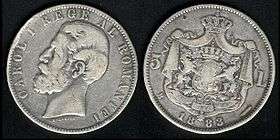

In 1860, the Domnitor Alexandru Ioan Cuza attempted to create a national românul ("The Romanian") and the romanat, however the project was not approved by the Ottoman Empire.[6]
On April 22, 1867, a bimetallic currency was adopted, with the leu equal to 5 grams of 83.5% silver or 0.29032 grams of gold. The first leu coin was minted in Romania in 1870.[6]
Before 1878 the silver Russian ruble was valued so highly as to drive the native coins out of circulation. Consequently, in 1889, Romania unilaterally joined the Latin Monetary Union and adopted a gold standard. Silver coins were legal tender only up to 50 lei. All taxes and customs dues were to be paid in gold and, owing to the small quantities issued from the Romanian mint, foreign gold coins were current, especially French 20-franc pieces (equal at par to 20 lei), Turkish gold lire (22.70), old Russian imperials (20.60) and British sovereigns (25.22).
Romania left the gold standard in 1914 and the leu's value fell. The exchange rate was pegged at 167.20 lei = 1 U.S. Dollar on February 7, 1929, 135.95 lei on November 5, 1936, 204.29 lei on May 18, 1940, and 187.48 Lei on March 31, 1941. During Romania's World War II alliance with Nazi Germany, the leu was pegged to the Reichsmark at a rate of 49.50 lei = 1 Reichsmark, falling to 59.5 lei in April 1941. During Soviet occupation, the exchange rate was 1 ruble = 100 lei. After the war, the value of the currency fell dramatically[7] and the National Bank issued a new lei, which was worth 20,000 old lei.[6]
Second leu: 1947-1952
A revaluation ("Great stabilization", marea stabilizare) took place on August 15, 1947, replacing the old leu at a rate of 20,000 old lei = 1 new leu.[6] No advance warning was given and there were limits for the sums to be converted in the new currency: 5 million old lei for farmers and 3 million old lei for workers and pensioners.[6]
Out of the 48.5 billion old lei in circulation, only around half were changed to new lei.[6] The most affected was the middle and upper classes, who were later also affected by the nationalization of 1948. At the time of its introduction, 150 new lei equaled 1 U.S. dollar.
Third leu (ROL): 1952-2005

On January 28, 1952, another new leu was introduced. Unlike the previous revaluation, different rates were employed for different kinds of exchange (cash, bank deposits, debts etc.) and different amounts. These rates ranged from 20 to 400 "old lei" for 1 "new" leu. Again, no advance warning was given before the reform took place.
Between 1970 and 1989, the official exchange rate was fixed by the government through law. This exchange rate was used by the government to calculate the value of foreign trade, but foreign currency was not available to be bought and sold by private individuals. Owning or attempting to buy or sell foreign currency was a criminal offence, punishable with a prison sentence that could go up to 10 years (depending on the amount of foreign currency found under one's possession). International trade was therefore considered as part of another economic circuit than domestic trade, and given greater priority.
This inflexibility and the existence of surplus money due to constant economic decline in the 1980s, mixed with the need for more foreign currency and the refusal of the Ceaușescu regime to accept inflation as a phenomenon in order to attain convertibility, led to one of the greatest supply side crises in Romanian history, culminating with the introduction of partial food rationing in 1980 and full rationing for all basic foods in 1986/87. This was a major factor in growing discontent with Ceaușescu, and contributed in part to the fall of the Communist regime in 1989.
In the post-communist period, there has been a switch in the material used for banknotes and coins. Banknotes have switched from special paper to special plastic, while coins switched from aluminum to more common coin alloys (probably partly due to technical limitations of coin-operated vending machines). The transition has been gradual for both, but much faster for the banknotes which are currently all made of plastic. There has been a period in which all banknotes were made of plastic and all coins were made of aluminum, a very distinctive combination.
In the 1990s, after the downfall of communism, inflation ran high due to reform failures, the legalization of owning foreign currency in 1990, reaching rates as high as 300% per year in 1993. By September 2003, one euro was exchanged for more than 40,000 lei, this being its peak value. Following a number of successful monetary policies in the late 1990s and early 2000s, the situation became gradually more stable, with one digit inflation in 2005.
The Romanian leu was briefly the world's least valued currency unit,[8] from January (when the Turkish lira dropped six zeros) to July 2005. However, the 1,000,000 lei bill was not the highest Romanian denomination ever. This distinction belongs to the 5 million lei bill from 1947.
Fourth leu (RON): 2005-Present
  | |
| 1,000,000 old lei 168 mm × 78 mm |
100 new lei 147 mm × 82 mm |
| Same design, different sizes. The images are to scale. | |
On 1 July 2005, the leu was revalued at the rate of 10,000 "old" lei (ROL) for one "new" leu (RON), thus psychologically bringing the purchasing power of the leu back in line with those of other major Western currencies. The term chosen for the action was "denominare", similar to the English "denomination". The first day brought difficulties adjusting to the new paper currencies and closed ATMs (that needed reprogramming) and forcing a new calculation habit that slowed down shops and annoyed some sales staff and older shoppers. The old ROL currency banknotes remained in circulation until December 31, 2006 (coins remained in circulation only until December 31, 2005), but all accounts have been converted starting July 1, 2005. There is no conversion time limit between the currencies. Retailers had to display prices in both old and new currency from March 1, 2005 until June 30, 2006. The appreciation of the leu during 2005 was about 20% against a basket of major currencies.
As of 2006, the revaluation was a potential source of confusion, especially to visitors, since both old and new currency values were commonly quoted. When written, the very large amounts in old currency are usually obvious, but in speaking inhabitants might refer to an amount of 5 new lei as simply "fifty" in reference to its value of 50,000 old lei.
| This article is part of a series on |
| Symbols of Romania |
|---|
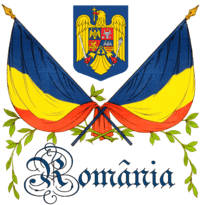 |
Speculation about joining the Eurozone
In 2014, Romania's Convergence Report set a target date of 1 January 2019 for euro adoption. As of April 2014, Romania meets 4 out of the 7 criteria. However, as of September 2015, the earliest feasible date for euro adoption in Romania is 2020, according to Romania's central bank governor Mugur Isarescu.[9]
Coins
The Romanian leu has a history of instability. As such, the size and composition of coins has changed frequently.
First Leu
In 1867, copper 1, 2, 5 and 10 bani were issued, with gold 20 lei (known as poli after the French Napoleons) first minted the next year. These were followed, between 1870 and 1873, by silver 50 bani, 1 and 2 lei. Silver 5 lei were added in 1880. Uniquely, the 1867 issue used the spelling 1 banu rather than 1 ban.
In 1900, cupro-nickel 5, 10 and 20 bani coins were introduced, with holed versions following in 1905. The production of coins ceased in 1914, recommencing in 1921 with aluminium 25 and 50 bani pieces. Cupro-nickel 1 and 2 lei coins were introduced in 1924, followed by nickel brass 5, 10 and 20 lei in 1930. In 1932, silver 100 lei coins were issued. However, inflation meant that in 1935, smaller silver 250 lei coins were introduced with nickel 100 lei coins being issued in 1936, followed by nickel 50 lei in 1937.
In 1941 and 1942, zinc 2, 5 and 20 lei coins were introduced, together with silver 200 and 500 lei. Nickel-clad-steel 100 lei followed in 1943, with brass 200 and 500 lei issued in 1945. In 1946 and 1947, postwar inflation brought the exchange rate even lower, and a new coinage was issued consisting of aluminium 500 lei, brass 2000 and 10,000 lei, and silver 25,000 and 100,000 lei.
Second Leu
Coins were issued in 1947 after the revaluation in denominations of 50 bani, 1, 2, and 5 leu and depicted the portrait of King Michael I. This coin series was brief, preceded by the king's abdication less than a year later and replaced following the establishment of communist administration in Romania in 1948, reissued gradually in denominations of 1, 2, 5, and 20 leu in nickel-brass alloy, and later in aluminum. All second leu coins were discontinued and devalued in late 1952.
Third Leu
Coins were first issued in 1952 in denominations of 1, 3, 5, 10, 25, and 50 bani, with aluminum bronze for 1, 3, and 5 bani, and cupro-nickel for 10, 25, and 50 bani. These coins featured the state arms and name "Republica Populara Româna."
In 1960, a new series of coins was issued in denominations of 5, 15, & 25 bani and 1, & 3 lei struck in nickel-plated steel. Starting in 1966, the name on all coins was changed to "Republica Socialista Romania" following the ascent of Nicolae Ceaușescu, though all pre-1966 coins of these denominations remained valid. In 1975, the composition of 5 & 15 bani coins was changed to aluminum, and the 25 bani followed suit in 1982. In 1978, an aluminum 5 Lei coin was introduced. These denominations remained in use until 1991, particularly the 5 lei following the lifting of state mandated exchange rates and price controls.
In 1991, a new coin series with post-communist iconography and new valuations was released in denominations of 1, 5, 10, 20, 50, and 100 lei. These coins gradually lost value with inflation, and a new series was introduced in 1998 with an aluminum-magnesium alloy 500 lei and 1,000 & 5,000 lei coins in 2000.
Fourth Leu
The coins that are currently in circulation are one ban, made of copper-plated steel; five bani, made of copper-plated steel; ten bani in nickel-plated steel; and fifty bani in aluminum-bronze. These were first introduced into circulation in 2005 with the fourth revaluation and are all currently valid. There are six 50 bani commemoratives circulating coins made in 2010, 2011, 2012, 2014, 2015 and 2016.
The current Coins of the Romanian leu are by any objective standards of functional austere design, surpassing in lack of decoration even the plainest Communist-era predecessors.
The one ban coin was rarely seen and not in demand by either banks or many retailers; the 'situation' has changed and the coin is not uncommonly found (as of 2015). Supermarkets continue habitually to advertise prices such as 9.99 (lei), and frequently price goods to the precise ban such as 9,47;[10] indeed, as of 2014, very few of the prices displayed at the Carrefour online site (for example) display prices to the nearest 5 or 10 bani. In practice, manyretailers round totals to the nearest 5 or 10 bani for cash payments, or even whole Leu, although (inter)national supermarket chains generally give exact change. For card payments the exact amount (not rounded) is always charged. The reversion to single ban pricing (and change giving) is perhaps due to the (effective) government drive for shops/businesses to give a receipt, an accurate bon fiscal (to avoid tax evasion) for every transaction. Official notices must be prominently displayed in all shops/restaurants that an accurate receipt must be given.
Banknotes
First leu
| 1917 fractional leu | ||
|---|---|---|
| 10 bani | 25 bani | 50 bani |
| |
|
|
In 1877, state notes were introduced in denominations of 5, 10, 20, 50, 100 and 500 lei. In 1880, these notes were overstamped for issue by the Banca Națională a României, which began to issue regular notes in 1881 in denominations of 20, 100 and 1000 lei.
In 1914, 5 lei notes were reintroduced, followed by 1 and 2 lei notes in 1915 and 500 lei in 1916. The Ministry of Finance issued very small sized notes for 10, 25 and 50 bani in 1917. 500 lei notes were introduced in 1940, followed by 10,000 and 100,000 lei in 1945 and 1 and 5 million lei in 1947. In 1945, the Ministry of Finance issued 20 and 100 lei notes to replace those of the National Bank's.
Second leu
In 1947, the Ministry of Finance introduced 20 lei notes and Banca Națională a României introduced 100, 500 and 1000 lei notes. In 1949, Banca Republicii Populare Române took over the production of paper money and issued 500 and 1000 lei notes.
Third leu
In 1952, the Ministry of Finance introduced notes for 1, 3 and 5 lei, and the Banca Republicii Populare Române introduced 10, 25 and 100 lei notes. In 1966, the Banca Națională a Republicii Socialiste România took over the production of all paper money, issuing notes for 1, 3, 5, 10, 25, 50 and 100 lei.
In 1991, 500 and 1000 lei notes were introduced, followed by 200 and 5000 lei notes in 1992, 10,000 lei in 1994, 50,000 lei in 1996, 100,000 lei in 1998, 500,000 lei in 2000 and 1 million lei in 2003. There was also a 2,000 lei note introduced in 1999; it celebrated the total solar eclipse that occurred on August 11, 1999. The final issues of the 2000, 10,000, 50,000, 100,000, 500,000 and 1 million lei were polymer notes.
Notes in circulation at the revaluation were:
- 10,000 lei (became 1 leu)
- 50,000 lei (became 5 lei)
- 100,000 lei (became 10 lei)
- 500,000 lei (became 50 lei)
- 1,000,000 lei (became 100 lei)
Fourth leu
In 2005, polymer notes were introduced for 1, 5, 10, 50, 100 and 500 lei. 200 lei notes were added in 2006. The designs of the 1, 5, 10, 50 and 100 lei notes are based on those of the earlier 10,000, 50,000, 100,000, 500,000 and 1 million lei notes which they replaced. The 10 lei note was redesigned in November 2008 (most of the graphic elements are identical, some of the safety elements were changed, making its safety features similar to the lower values of 1 leu and 5 lei notes). The highest value coin (in general circulation) is 50 Bani (around 15 US cents or nine GB Pence); the one Leu note/bill (there is no coin) has, therefore, a value of (approximately) 30 US cents or 18 pence (GB Sterling), or around 23 Euro cents.
List of current banknotes
| Value | Image | Dimensions (millimeters) | Main Colour | Description | First Series | Latest Series | ||
|---|---|---|---|---|---|---|---|---|
| Obverse | Reverse | Obverse | Reverse | |||||
| 1 leu |  |
 |
120 × 62 | Green | Nicolae Iorga and milkweed gentian | Cathedral of Curtea de Argeş | Series 2005 | |
| 5 lei |  |
 |
127 × 67 | Violet | George Enescu and carnation | Romanian Athenaeum | ||
| 10 lei |  |
 |
133 × 72 | Pink and light red | Nicolae Grigorescu and althaea | Traditional house from Oltenia, Nicolae Grigorescu painting Rodica | Series 2005 | Series 2008 |
| 50 lei | 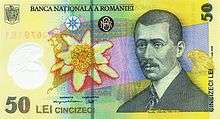 |
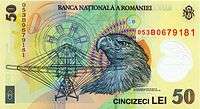 |
140 × 77 | Yellow | Aurel Vlaicu and edelweiss | Vlaicu II airplane design, eagle head | Series 2005 | |
| 100 lei |  |
 |
147 × 82 | Blue | Ion Luca Caragiale and sweet violet | National Theatre of Bucharest (old building), Statue of Ion Luca Caragiale, by Constantin Baraschi | ||
| 200 lei | 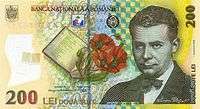 |
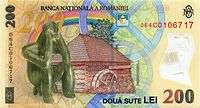 |
150 × 82 | Brown and orange | Lucian Blaga and poppies | A watermill and the Hamangia Thinker | Series 2006 | |
| 500 lei | 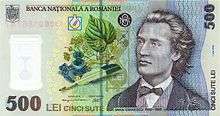 |
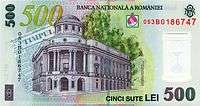 |
153 × 82 | Blue and violet | Mihai Eminescu and tilia | Central University Library of Iaşi | Series 2005 | |
| Current RON exchange rates | |
|---|---|
| From Google Finance: | AUD CAD CHF EUR GBP HKD JPY USD |
| From Yahoo! Finance: | AUD CAD CHF EUR GBP HKD JPY USD |
| From XE: | AUD CAD CHF EUR GBP HKD JPY USD |
| From OANDA: | AUD CAD CHF EUR GBP HKD JPY USD |
| From fxtop.com: | AUD CAD CHF EUR GBP HKD JPY USD |
See also
References
- ↑ Banca Națională a României: Current value of inflation (October 2016 / October 2015)
- ↑ http://www.bnr.ro/Home.aspx
- ↑ Euro Exhibition - Opening Speech by Mugur Isărescu, NBR Governor, BNR.ro
- ↑ Numismatic issue - a set of three collector coins dedicated to 140 years since the establishment of military communications, BNR.ro
- ↑ Romanian New Leu, oanda.com
- 1 2 3 4 5 6 Gruia, Cătălin (2012). "Metamorfozele leului" (PDF). National Geographic Romania (July 2012). Retrieved April 21, 2013.
- ↑ Romania New Leu, Global Financial Data.com
- ↑ "Romaniam Leu is the least valued currency unit in the world". Banii Nostri. 2005-04-18. Retrieved 2008-09-28.
- ↑ "Central Bank: Romania 2019 euro membership 'not feasible'.". EUObserver. 2015-09-30. Retrieved 2015-12-30.
- ↑ (Romanian) Gândul, Moneda de 1 ban n-are căutare, November 3, 2005. Accessed on January 1, 2007
External links
| Wikinews has related news: Romania redenominates its currency |

.jpg)
.jpg)
.jpg)